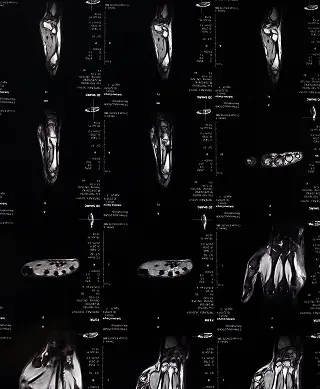
The Human Body’s Energy Metabolism Systems
Introduction
Just like a car needs fuel to run and a machine requires electricity to operate, energy is essential for anything that moves—or in other words, does “work.” The human body is no different. It functions as a machine powered by electrical signals and constantly requires energy to perform. To meet this demand, the body uses adenosine triphosphate (ATP) as its immediate source of energy for cellular activity. ATP is produced through three primary pathways.
Major Energy Metabolism Pathways in the Body
The human body produces energy through the following three pathways. Each differs in its main fuel source, speed of ATP production, location, and duration of activity:
(1) ATP-PCr System (Phosphagen System)
(2) Glycolysis
(3) Aerobic Metabolism in the Mitochondria (TCA cycle, oxidative phosphorylation, etc.)
1. ATP-PCr System (Phosphagen System)
The ATP-PCr system activates immediately at the start of intense activity and takes place within the muscles. This mechanism uses phosphocreatine (PCr) stored in the muscle. PCr breaks down into phosphate (Pi) and creatine (Cr), and the energy released in the process is used to regenerate ATP. This pathway is anaerobic (does not require oxygen) and is the fastest way to produce ATP. However, since the muscle stores only a limited amount of PCr, the system can sustain energy production for only a short duration. It is most effective in high-intensity activities lasting under 10 seconds, such as sprinting or powerlifting.
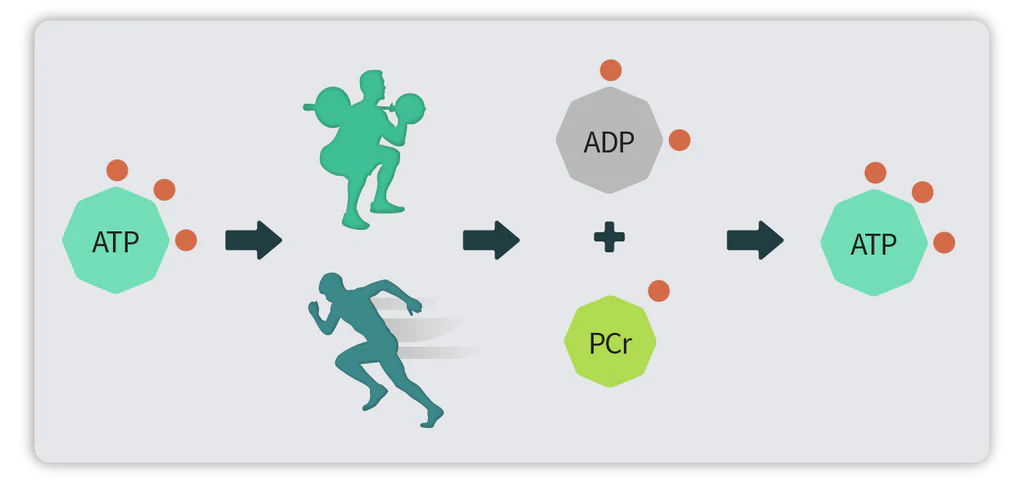
Characteristics
- Fastest ATP production method
- Ideal for sprinting, powerlifting, and other explosive movements
Mechanism
- Uses phosphocreatine stored in muscles
- Energy released from PCr breakdown converts ADP into ATP
- Anaerobic (no oxygen required)
Duration
- Very short due to limited PCr stores
- Dominant in high-intensity activities under 10 seconds
2. Glycolysis
Glycolysis produces ATP using glucose derived from glycogen stored in the muscles or liver, as well as from blood glucose. This process takes place primarily in the cytoplasm and breaks down glucose to generate energy. Glycolysis can be either aerobic or anaerobic depending on the availability of oxygen. In the cytoplasm, glucose is converted into two molecules of pyruvic acid, releasing energy in the process. This pathway is relatively fast but less efficient, yielding only 2–3 ATP molecules per glucose molecule. Pyruvate, the end product of glycolysis, is a key metabolic intermediate. If sufficient oxygen is available, it enters the mitochondria for aerobic metabolism, producing much more ATP. If oxygen is lacking, pyruvate is reduced to lactate (lactic acid), which may cause fatigue. Due to its moderate efficiency and speed, glycolysis is the dominant pathway for activities lasting between 20 seconds and 2 minutes, especially at moderate intensity. However, depending on oxygen availability and exercise intensity, glycolysis can also contribute to longer-duration efforts. Additionally, lactate produced through anaerobic glycolysis can be recycled. When oxygen becomes available, lactate is converted back to pyruvate for mitochondrial metabolism or sent to the liver for conversion back into glucose (the Cori cycle).
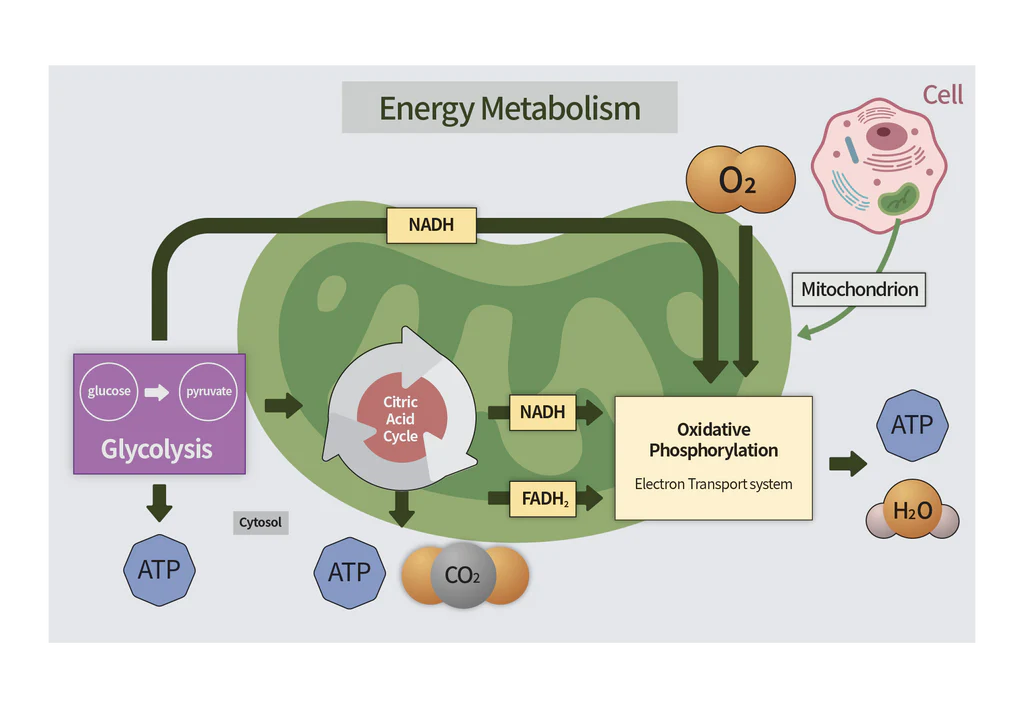
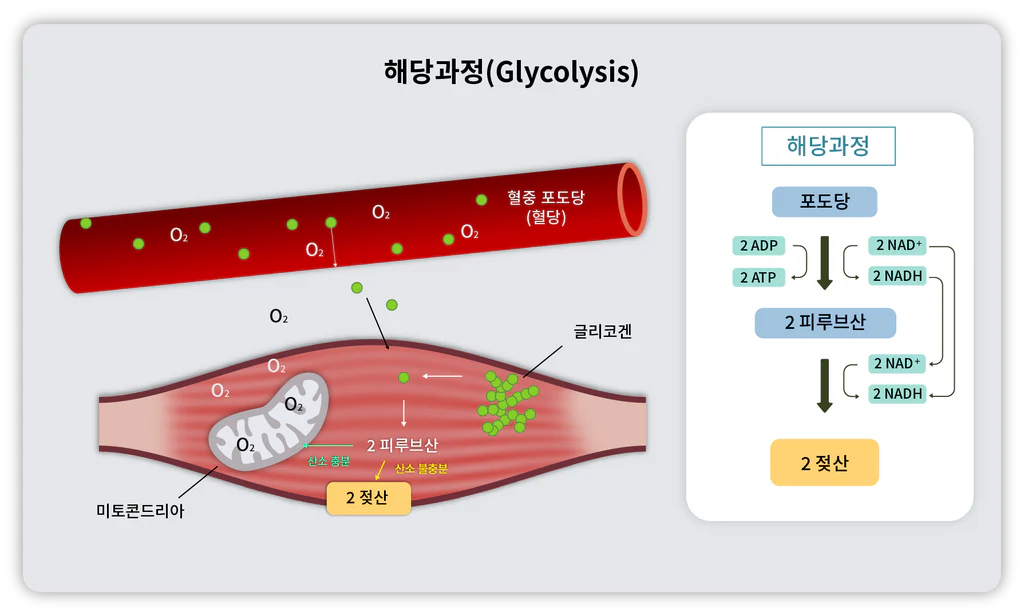
Characteristics
- Occurs primarily in the cytoplasm
- Divided into aerobic and anaerobic glycolysis
- Relatively fast but less efficient
- Best suited for moderate-intensity activities
Mechanism
- Glucose (from glycogen or blood) is broken down into pyruvate
- Produces 2–3 ATP per glucose molecule
- Without oxygen: pyruvate is converted into lactate
- With oxygen: pyruvate enters the mitochondria for further ATP production
Duration
- Primary pathway for activity lasting ~30 seconds to 2 minutes
- Can continue to contribute beyond that depending on intensity and oxygen availability
3. Aerobic Metabolism in the Mitochondria (Oxidative Phosphorylation, etc.)
While the ATP-PCr system and glycolysis produce energy quickly, they are not very efficient or sustainable. For long-duration energy needs, the body relies on a more efficient system: aerobic metabolism in the mitochondria, commonly referred to as “aerobic respiration.” Mitochondria function like power plants in the cell. They utilize pyruvate from glycolysis, as well as other fuels such as amino acids and fatty acids. Approximately 15 ATP are generated from each pyruvate molecule, and over 100 ATP from a single fatty acid molecule. This method provides large amounts of ATP with high efficiency and can be sustained almost indefinitely due to the availability of body fat as fuel. However, it requires a steady supply of oxygen. Because oxygen must reach the mitochondria and be used in ATP production, this system takes longer to activate. As such, mitochondrial aerobic metabolism becomes dominant during low-intensity or prolonged exercise in a steady state.
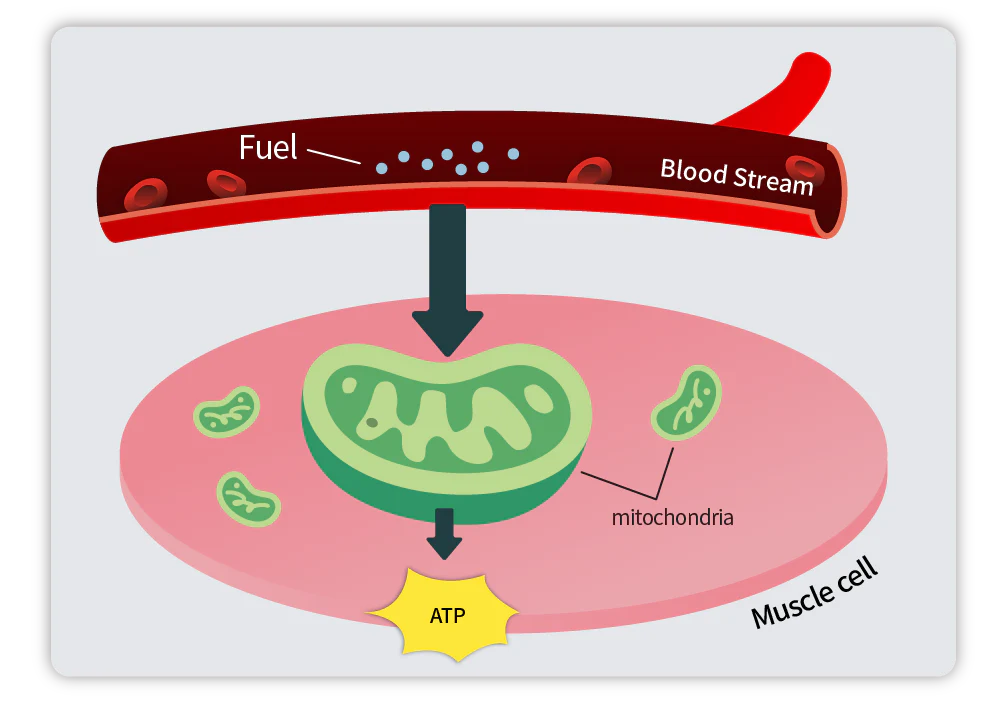
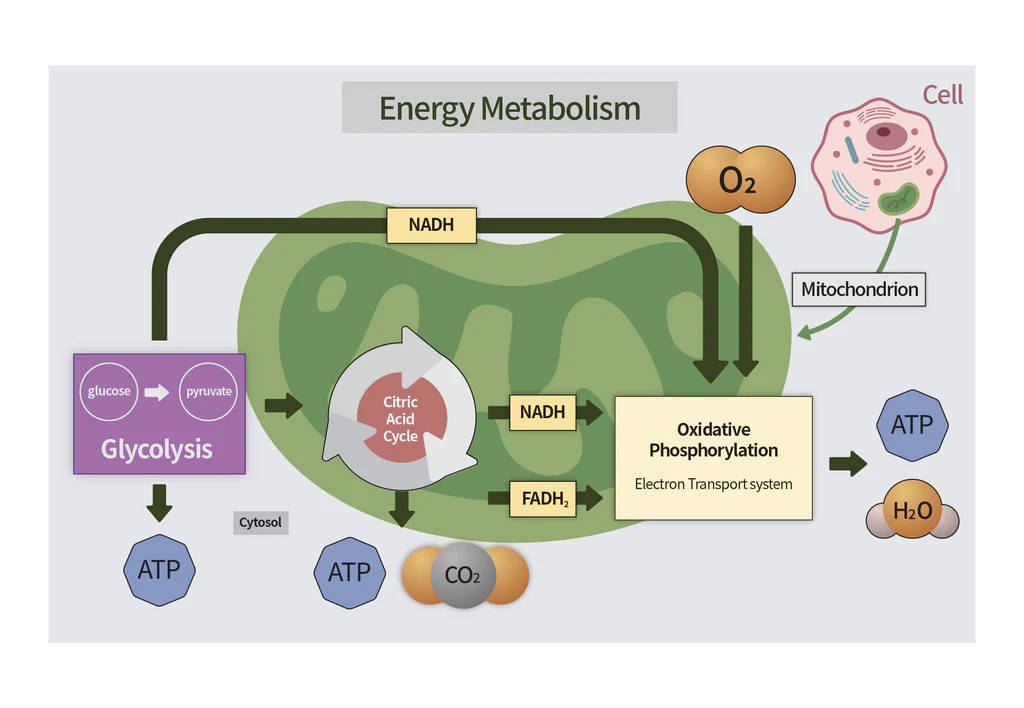
Characteristics
- Takes place in the mitochondria
- Slowest but most efficient and sustainable method of ATP production
- Ideal for low-intensity or long-duration exercise
- Requires oxygen and can use a variety of organic substrates
Mechanism
- Oxidizes fuels into water and carbon dioxide, generating large amounts of ATP
- Produces ~28–30 ATP per glucose molecule (~15 ATP per pyruvate)
- Produces over 100 ATP per fatty acid
Duration
- Dominant in exercise lasting over 2 minutes
- Best suited for low-intensity activity with stable oxygen supply
- Primary pathway for endurance exercise
- Can theoretically produce unlimited energy using fat stores
- May be less active at higher intensities or under low oxygen availability
Interaction Between Energy Systems
Just because an activity like running is considered aerobic doesn’t mean only mitochondrial metabolism is active. At the start of running, the ATP-PCr system activates first, followed by glycolysis, and then aerobic metabolism kicks in. Even while aerobic metabolism is ongoing, glycolysis continues in parallel. As running intensity increases, glycolysis becomes more dominant, but oxygen intake via respiration still supports mitochondrial activity. ATP may also be supplemented by the breakdown of phosphocreatine.
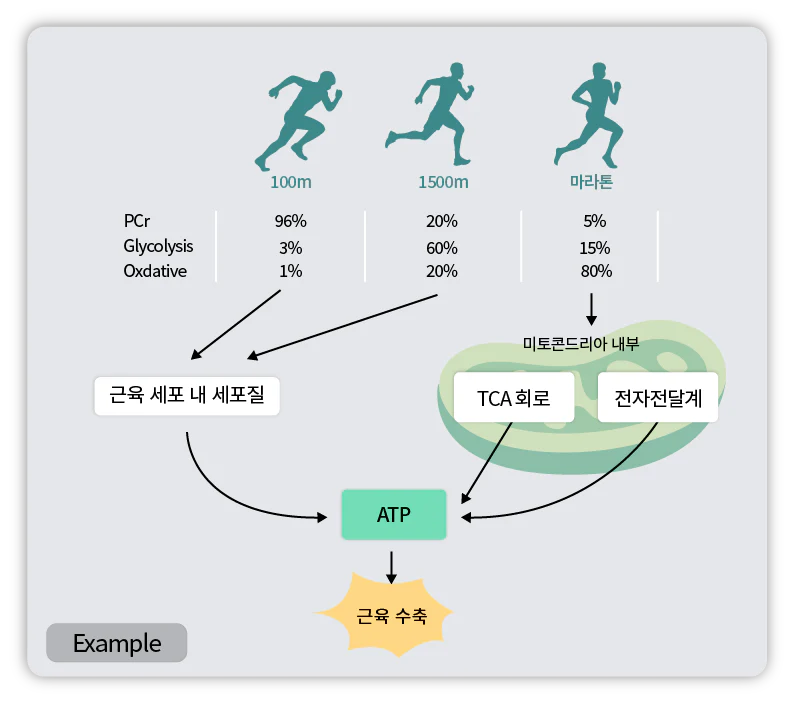
In other words, the dominant ATP production pathway depends on exercise duration and intensity, so it’s not possible to assign a single pathway to every activity. The three systems interact and complement each other. The body has evolved to select the most efficient energy pathway for any given condition. To improve exercise performance, it is helpful to understand the exercise intensity and environment, which energy systems are primarily being used, how those systems produce energy, and what types of nutrients support each pathway.
References
- Books
- Lodish, H., Berk, A., Kaiser, C. A., Krieger, M., Bretscher, A., Ploegh, H., ... Yaffe, M. B. (2023). Molecular Cell Biology (9th ed.). World Science.
- Berg, J. M., Tymoczko, J. L., & Stryer, L. (2012). Biochemistry (7th ed.). Bummun Education.
- Brooks, G. A., Fahey, T. D., & Baldwin, K. M. (2010). Exercise Physiology (4th ed.). Rainbow Books.
- Hargreaves, M., & Spriet, L. L. (2006). Exercise Metabolism. Human Kinetics.
- Kenney, W. L., Wilmore, J., & Costill, D. L. (2019). Physiology of Sport and Exercise (7th ed.). Human Kinetics.
- McArdle, W. D., Katch, F. I., & Katch, V. L. (2014). Exercise Physiology: Nutrition, Energy, and Human Performance (8th ed.). Lippincott Williams & Wilkins.
- Korean Society of Exercise Physiology. (2014). Exercise Physiology (2nd ed.). Hanmi Medical.
- Articles
- Hargreaves, M., & Spriet, L. L. (2018). Exercise metabolism: Fuels for the fire. Cold Spring Harbor Perspectives in Medicine, 8(8), a029744.
- Hargreaves, M., & Spriet, L. L. (2020). Skeletal muscle energy metabolism during exercise. Nature Metabolism, 2(9), 817–828.